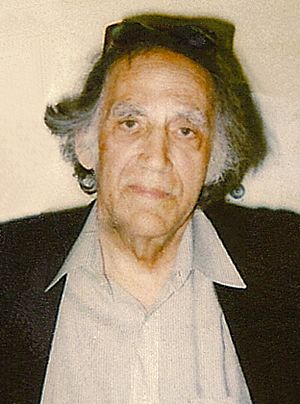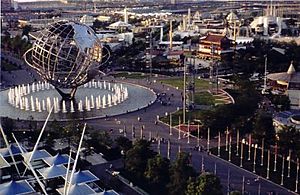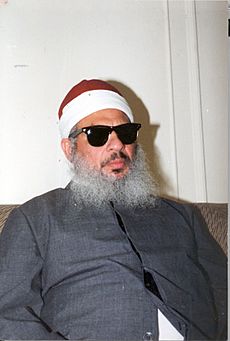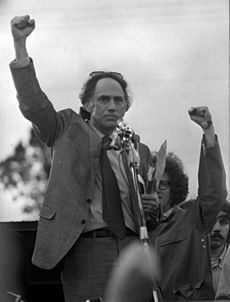William Kunstler facts for kids
Quick facts for kids
William Kunstler
|
|
|---|---|
 |
|
| Born |
William Moses Kunstler
July 7, 1919 New York City, U.S.
|
| Died | September 4, 1995 (aged 76) New York City, U.S.
|
| Education | Yale University (BA) Columbia University (LLB) |
| Occupation | Lawyer, civil rights activist |
| Spouse(s) | Lotte Kunstler Margaret Ratner |
| Children | 4, including Emily |
William Moses Kunstler (July 7, 1919 – September 4, 1995) was an American lawyer and civil rights activist, known for defending the Chicago Seven. Kunstler was an active member of the National Lawyers Guild, a board member of the American Civil Liberties Union (ACLU) and the co-founder of the Center for Constitutional Rights (CCR), the "leading gathering place for radical lawyers in the country."
Kunstler's defense of the Chicago Seven from 1969 to 1970 led The New York Times to label him "the country's most controversial and, perhaps, its best-known lawyer". Kunstler is also well known for defending members of the Revolutionary Communist Party, Catonsville Nine, Black Panther Party, Weather Underground Organization, the Attica Prison rioters, Meir Kahane assassin El Sayyid Nosair, and the American Indian Movement. He also won a de facto segregation case regarding the District of Columbia's public schools and "disinterred, singlehandedly" the concept of federal criminal removal jurisdiction in the 1960s. Kunstler refused to defend right-wing groups, such as the Minutemen, on the grounds that "I only defend those whose goals I share. I'm not a lawyer for hire. I only defend those I love."
He was a polarizing figure; many on the right wished to see him disbarred, while many on the left admired him as a "symbol of a certain kind of radical lawyer." Even some other civil rights lawyers regarded Kunstler as a "publicity hound and a hit-and-run lawyer" who "brings cases on Page 1 and the NAACP Legal Defense Fund wins them on Page 68." Legal writer Sidney Zion quipped that Kunstler was "one of the few lawyers in town who knows how to talk to the press. His stories always check out and he's not afraid to talk to you, and he's got credibility—although you've got to ask sometimes, 'Bill, is it really true?'"
Contents
Early life
Kunstler was born to a Jewish family in New York City, the son of Frances Mandelbaum and Monroe Bradford Kunstler, a physician. He attended DeWitt Clinton High School. After high school, he attended Yale University, where he majored in French and graduated Phi Beta Kappa in 1941. He then went on to attend Columbia Law School from which he graduated in 1948. While at Yale, Kunstler was an avid poet and represented Yale in the Glascock Prize competition at Mount Holyoke College.
Rejected twice by the United States Navy, Kunstler served in the U.S. Army during World War II in the Pacific theater. He volunteered for cryptography and served in New Guinea. He rose to the rank of Major, and received the Bronze Star. While in the army, he was noted for his theatric portrayals in the Fort Monmouth Dramatic Association.
After his discharge from the Army he attended law school, was admitted to the bar in New York in 1948 and began practicing law. Kunstler went through R.H. Macy's executive training program in the late 1940s and practiced family and small business law in the 1950s, before entering civil rights litigation in the 1960s. He was an associate professor of law at New York Law School (1950–1951).
Kunstler won honorable mention for the National Legal Aid Association's press award in 1957 for his series of radio broadcasts on WNEW, "The Law on Trial". At WNEW, Kunstler also conducted interviews on controversial topics on a program called Counterpoint.
Civil rights career
Rise to prominence (1957–1964)

Kunstler first made headlines in 1957 when he unsuccessfully defended William Worthy, a correspondent for the Baltimore Afro-American, who was one of forty-two Americans who had their passports seized after violating the State Department's travel ban on Communist China (after attending a Communist youth conference in Moscow). Kunstler refused a State Department compromise which would have returned Worthy's passport if he agreed to cease visiting Communist countries, a condition Worthy considered unconstitutional.
Kunstler played an important role as a civil rights lawyer in the 1960s, traveling to many of the segregated battlegrounds to work to free those who had been jailed. Working on behalf of the ACLU, Kunstler defended the Freedom Riders in Mississippi in 1961. Kunstler filed for a writ of habeas corpus with Sidney Mize, a federal judge in Biloxi, and appealed to the Fifth Circuit; he also filed similar pleas in state courts. Judge Leon Hendrick in Hinds County refused Kunstler's motion to cancel the mass appearance (involving hundreds of miles of travel) of all 187 convicted riders. The riders were convicted in a bench trial in Jackson and appealed to a county jury trial, where Kunstler argued that the county systematically discriminated against African-American jurors.
In 1962, Kunstler took part in efforts to integrate public parks and libraries in Albany, Georgia. Later that year, he published The Case for Courage (modeled on President Kennedy's Profiles in Courage) highlighting the efforts of other lawyers who risked their careers for controversial clients as well as similar acts by public servants. At the time of the publication, Kunstler was already well known for his work with the Freedom Riders and his radio coverage of trials. Kunstler also joined a group of lawyers criticizing the application of Alabama's civil libel laws and spoke at a rally against HUAC.
In 1963, for the Gandhi Society of New York, Kunstler filed to remove the cases of more than 100 arrested African-American demonstrators from the Danville Corporation Court to the Charlottesville District Court, under a Reconstruction Era statute. Although the district judge remanded the cases to city court, he dissolved the city's injunction against demonstrations. In doing so, Judge Thomas J. Michie rejected a Justice Department amicus curiae brief urging the removal to create a test case for the statute. Kunstler appealed to the Fourth Circuit. That year Kunstler also sued public housing authorities in Westchester County.
In 1964, Kunstler defended a group of four accused of kidnapping a white couple, and succeeded in getting the alleged weapons thrown out as evidence, as they could not be positively identified as those used. That year he also challenged Mississippi's unpledged elector law as well as racial segregation in primary elections; he also defended three members of the Blood Brothers, a Harlem gang, charged with murder.
Kunstler went to St. Augustine, Florida in 1964 during the demonstrations led by Dr. Martin Luther King Jr. and Dr. Robert B. Hayling which put added pressure on Congress to pass the landmark Civil Rights Act of 1964. Kunstler brought the first federal case under Title IX of the Civil Rights Act of 1964, which allowed the removal of cases from county court to be appealed; the defendants were protestors at the 1964 New York World's Fair.
ACLU director (1964–1972)
He was a director of the American Civil Liberties Union (ACLU) from 1964 to 1972, when he became a member of the ACLU National Council. In 1966 he co-founded the Center for Constitutional Rights. Kunstler also worked with the National Lawyers Guild.
In 1965, Kunstler's firm Kunstler, Kunstler, and Kinoy was asked to defend Jack Ruby by his brother Earl, but dropped the case because they "did not wish to be in a situation where we have to fight to get into the case". Ruby was eventually permitted to replace his original defense team with Kunstler, who got him a new trial. In 1966, he also defended an arsonist who burned down a Jewish Community Center, killing twelve, because he was not provided a lawyer before he signed a confession.
Kunstler's other notable clients include: H. Rap Brown, Stokely Carmichael, the Catonsville Nine, Angela Davis, Gregory Lee Johnson, Martin Luther King Jr., Gary McGivern, Adam Clayton Powell, Jr., Filiberto Ojeda Rios, Assata Shakur, Morton Sobell, and Michael X.
Chicago Seven (1969–1972)
While defending the Chicago Seven, he put the war in Vietnam on trial – asking Judy Collins to sing "Where Have All The Flowers Gone" from the witness stand, placing a Viet Cong flag on the defence table, and wearing a black armband to commemorate the war dead.
Kunstler gained national renown for defending the Chicago Seven (originally Chicago Eight), in a five-month trial in 1969–1970, against charges of conspiring to incite riots in Chicago during the 1968 Democratic National Convention. Under cross-examination, Kunstler got a key police witness to contradict his previous testimony and admit that he had not witnessed Jerry Rubin, but had rather been given his name two weeks later by the FBI. Another prosecution witness, photographer Louis Salzberg, admitted under Kunstler's cross-examination that he was still on the payroll of the FBI.
The trial was marked by frequent clashes between Kunstler and U.S. Attorney Thomas Foran, with Kunstler taking the opportunity to accuse the government of failing to "realize the extent of antiwar sentiment". Kunstler also sparred with Judge Julius Hoffman, on one occasion remarking (with respect to the number of federal marshals): "this courtroom has the appearance of an armed camp. I would note that the Supreme Court has ruled that the appearance of an armed camp is a reversible error". During one heated exchange, Kunstler informed Hoffman that his entry in Who's Who was three times longer than the judge's, to which the judge replied "I hope you get a better obituary". Kunstler and co-defense attorneys Leonard Weinglass, Michael Kennedy, Gerald Lefcourt, Dennis Roberts and Michael Tigar were cited for contempt (the convictions were later overturned unanimously by the Seventh Circuit). If Hoffman's contempt conviction had been allowed to stand, Kunstler would have been imprisoned for an unprecedented four years.
The progress of the trial—which had many aspects of guerrilla theater—was covered on the nightly news and made Kunstler the best-known lawyer in the country, and something of a folk hero. After much deadlock, the jury acquitted all seven on the conspiracy charge, but convicted five of violating the anti-riot provisions of the Civil Rights Act of 1968. The Seventh Circuit overturned all the convictions on November 21, 1972, due to Hoffman's refusal to let defense lawyers question the prospective jurors on racial and cultural biases; the Justice Department did not retry the case.
Shortly after the 1968 Democratic Convention, Tom Hayden, Rennie Davis, Abbie Hoffman, Jerry Rubin, Dave Dellinger and Robert Greenblatt received subpoenas to appear before the House Un-American Activities Committee (HUAC). Kunstler and co-counsel, Michael Kennedy, were among the group's six defense attorneys.
On the opening day of the HUAC hearings, the subpoenaed men and their lawyers, including Kunstler and Kennedy, staged a “stand-in” to protest the investigations.
American Indian Movement (1973–1976)
Kunstler arrived in Pine Ridge, South Dakota on March 4, 1973, to draw up the demands of the American Indian Movement (AIM) members involved in the Wounded Knee incident. Kunstler, who headed the defense, called the trial "the most important Indian trial of the 20th century", attempting to center the defense on the Treaty of Fort Laramie (1868). Kunstler's team represented Russell Means and Dennis Banks, two of the leaders of the occupation.
Kunstler objected to the heavy trial security on the grounds that it could prejudice the jury and Judge Fred J. Nichol agreed to ease measures. The trial was moved to Minnesota. Two authors and three Sioux were called as defense witnesses, mostly focusing on the historical (and more recent) injustice against the Sioux on the part of the U.S. government, shocking the prosecution.
In 1975, Kunstler again defended AIM members in the slaying of two FBI agents at Pine Ridge Indian Reservation, not far from the site of the Wounded Knee incident. At the trial in 1976, Kunstler subpoenaed prominent government officials to testify about the existence of a Counter-Intelligence Program (COINTELPRO) against Native American activists. District Judge Edward J. McManus approved Kunstler's attempt to subpoena FBI director Clarence M. Kelley.
Kunstler also defended a Native American woman who refused to send her daughter with muscular dystrophy to school.
Collaboration with Ron Kuby (1983–1995)

From 1983 until Kunstler's death in 1995, Ron Kuby was his partner. The two took on controversial civil rights and criminal cases.
Kunstler's defense of the three clerics made him "more visible, more venerated, more vilified than ever".
During the first Gulf War, they represented dozens of American soldiers who refused to fight and claimed conscientious objector status.
Representation of mobsters
Kunstler represented a number of convicted mafiosi during his career, claiming "they were victims of government persecution", and said to have "never made a nickel on an OC [organized crime] case". The more notorious of Kunstler's mobster clients included Joe Bonanno, Raymond L.S. Patriarca, Nicholas L. Bianco, John Gotti, and Louis Ferrante, who claimed in his memoir, Unlocked: the Life and Crimes of a Mafia Insider, that Kunstler "took a hundred grand off me."
Other work
In 1979, Kunstler represented Marvin Barnes, an ABA and NBA basketball player, with past legal troubles and league discipline problems.
In 1989–1990, Kunstler twice argued successfully in defense of flag burning, before the Supreme Court. In Texas v. Johnson and United States v. Eichman, the Court held the act to be protected speech under the First Amendment, striking down Texas state and Federal statutes on "flag desecration".
Kunstler appeared as a lawyer in the movie The Doors in 1991, as a judge in the movie Malcolm X in 1992, and as himself in several television documentaries.
In 1993 Kunstler represented Yusuf Saalam of the Central Park 5 during his appeal, a move which alienated several friends. After Kunstler's death Saalam would be proven innocent when Matias Reyes confessed and DNA proved that Reyes was the sole attacker.
During the 1994–95 television season, Kunstler starred as himself in an episode of Law & Order titled "White Rabbit".
Death and legacy
In late 1995, Kunstler died in New York City of heart failure at the age of 76. In his last major public appearance, at the commencement ceremonies for the University at Buffalo's School of Architecture and Planning, Kunstler lambasted the death penalty, saying, "We have become the charnel house of the Western world with reference to executions; the next closest to us is the Republic of South Africa." Ron Kuby, in his eulogy of Kunstler, said "While defending the Chicago Seven, [Kunstler] put the war in Vietnam on trial, asking Judy Collins to sing "Where Have All The Flowers Gone?" from the witness stand, placing a Viet Cong flag on the defense table, and wearing a black armband to commemorate the war dead."
William Kunstler was survived by his wife Margaret Ratner Kunstler (who was previously married to Kunstler's close friend Michael Ratner) and his four daughters Karin Kunstler Goldman, Jane Drazek, Sarah Kunstler and Emily Kunstler, and several grandchildren.
Emily Kunstler and Sarah Kunstler produced a documentary about their father entitled William Kunstler: Disturbing the Universe, which had a screening as part of the Documentary Competition of the 2009 Sundance Film Festival.


